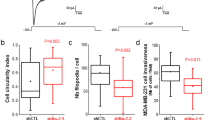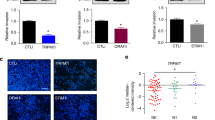Abstract
NaV1.5 sodium channels enhance the invasiveness of breast cancer cells through the acidic-dependent activation of cysteine cathepsins. Here, we showed that the Na+/H+ exchanger type 1 (NHE1) was an important regulator of H+ efflux in breast cancer cells MDA-MB-231 and that its activity was increased by NaV1.5. NaV1.5 and NHE1 were colocalized in membrane rafts containing caveolin-1. The inhibition of NaV1.5 or NHE1 induced a similar reduction in cell invasiveness and extracellular matrix degradation; no additive effect was observed when they were simultaneously inhibited. Our study suggests that NaV1.5 and NHE1 are functionally coupled and enhance the invasiveness of cancer cells by increasing H+ efflux.
This is a preview of subscription content, access via your institution
Access options
Subscribe to this journal
Receive 50 print issues and online access
$259.00 per year
only $5.18 per issue
Buy this article
- Purchase on Springer Link
- Instant access to full article PDF
Prices may be subject to local taxes which are calculated during checkout




Similar content being viewed by others
References
Bourguignon LY, Singleton PA, Diedrich F, Stern R, Gilad E . (2004). CD44 interaction with Na+-H+ exchanger (NHE1) creates acidic microenvironments leading to hyaluronidase-2 and cathepsin B activation and breast tumor cell invasion. J Biol Chem 279: 26991–27007.
Busco G, Cardone RA, Greco MR, Bellizzi A, Colella M, Antelmi E et al. (2010). NHE1 promotes invadopodial ECM proteolysis through acidification of the peri-invadopodial space. Faseb J 24: 3903–3915.
Calaghan S, Kozera L, White E . (2008). Compartmentalisation of cAMP-dependent signalling by caveolae in the adult cardiac myocyte. J Mol Cell Cardiol 45: 88–92.
Cardone RA, Casavola V, Reshkin SJ . (2005). The role of disturbed pH dynamics and the Na+/H+ exchanger in metastasis. Nat Rev Cancer 5: 786–795.
Diaz D, Delgadillo DM, Hernandez-Gallegos E, Ramirez-Dominguez ME, Hinojosa LM, Ortiz CS et al. (2007). Functional expression of voltage-gated sodium channels in primary cultures of human cervical cancer. J Cell Physiol 210: 469–478.
Egeblad M, Werb Z . (2002). New functions for the matrix metalloproteinases in cancer progression. Nat Rev Cancer 2: 161–174.
Fraser SP, Diss JK, Chioni AM, Mycielska ME, Pan H, Yamaci RF et al. (2005). Voltage-gated sodium channel expression and potentiation of human breast cancer metastasis. Clin Cancer Res 11: 5381–5389.
Gatenby RA, Smallbone K, Maini PK, Rose F, Averill J, Nagle RB et al. (2007). Cellular adaptations to hypoxia and acidosis during somatic evolution of breast cancer. Br J Cancer 97: 646–653.
Gillet L, Roger S, Besson P, Lecaille F, Gore J, Bougnoux P et al. (2009). Voltage-gated sodium channel activity promotes cysteine cathepsin-dependent invasiveness and colony growth of human cancer cells. J Biol Chem 284: 8680–8691.
Giusti I, D'Ascenzo S, Millimaggi D, Taraboletti G, Carta G, Franceschini N et al. (2008). Cathepsin B mediates the pH-dependent proinvasive activity of tumor-shed microvesicles. Neoplasia 10: 481–488.
Gore J, Besson P, Hoinard C, Bougnoux P . (1994). Na(+)-H+ antiporter activity in relation to membrane fatty acid composition and cell proliferation. Am J Physiol 266: C110–C120.
Gupta GP, Massague J . (2006). Cancer metastasis: building a framework. Cell 127: 679–695.
Kraus M, Wolf B . (1996). Implications of acidic tumor microenvironment for neoplastic growth and cancer treatment: a computer analysis. Tumour Biol 17: 133–154.
Laemmli UK . (1970). Cleavage of structural proteins during the assembly of the head of bacteriophage T4. Nature 227: 680–685.
Laniado ME, Lalani EN, Fraser SP, Grimes JA, Bhangal G, Djamgoz MB et al. (1997). Expression and functional analysis of voltage-activated Na+ channels in human prostate cancer cell lines and their contribution to invasion in vitro. Am J Pathol 150: 1213–1221.
Martinez-Zaguilan R, Seftor EA, Seftor RE, Chu YW, Gillies RJ, Hendrix MJ . (1996). Acidic pH enhances the invasive behavior of human melanoma cells. Clin Exp Metastasis 14: 176–186.
Moellering RE, Black KC, Krishnamurty C, Baggett BK, Stafford P, Rain M et al. (2008). Acid treatment of melanoma cells selects for invasive phenotypes. Clin Exp Metastasis 25: 411–425.
Mohamed MM, Sloane BF . (2006). Cysteine cathepsins: multifunctional enzymes in cancer. Nat Rev Cancer 6: 764–775.
Parkin DM, Bray F, Ferlay J, Pisani P . (2005). Global cancer statistics, 2002. CA Cancer J Clin 55: 74–108.
Roger S, Besson P, Le Guennec JY . (2003). Involvement of a novel fast inward sodium current in the invasion capacity of a breast cancer cell line. Biochim Biophys Acta 1616: 107–111.
Roger S, Potier M, Vandier C, Besson P, Le Guennec JY . (2006). Voltage-gated sodium channels: new targets in cancer therapy? Curr Pharm Des 12: 3681–3695.
Roger S, Rollin J, Barascu A, Besson P, Raynal PI, Iochmann S et al. (2007). Voltage-gated sodium channels potentiate the invasive capacities of human non-small-cell lung cancer cell lines. Int J Biochem Cell Biol 39: 774–786.
Rozhin J, Sameni M, Ziegler G, Sloane BF . (1994). Pericellular pH affects distribution and secretion of cathepsin B in malignant cells. Cancer Res 54: 6517–6525.
Stock C, Schwab A . (2009). Protons make tumor cells move like clockwork. Pflugers Arch 458: 981–992.
Tekpli X, Huc L, Lacroix J, Rissel M, Poet M, Noel J et al. (2008). Regulation of Na+/H+ exchanger 1 allosteric balance by its localization in cholesterol- and caveolin-rich membrane microdomains. J Cell Physiol 216: 207–220.
Xu SZ, Zeng F, Lei M, Li J, Gao B, Xiong C et al. (2005). Generation of functional ion-channel tools by E3 targeting. Nat Biotechnol 23: 1289–1293.
Yamaguchi H, Takeo Y, Yoshida S, Kouchi Z, Nakamura Y, Fukami K . (2009). Lipid rafts and caveolin-1 are required for invadopodia formation and extracellular matrix degradation by human breast cancer cells. Cancer Res 69: 8594–8602.
Acknowledgements
We thank Dr Lin-Hua Jiang (University of Leeds, UK) for comments about the manuscript. We are grateful to Dr Ming Lei (University of Manchester, UK) for the generous gift of the anti-NaV1.5 antibody. This work was supported by the ‘Ministère de la Recherche et des Technologies’ and the ‘Institut National de la Santé et de la Recherche Médicale’ (Inserm), the ‘Association CANCEN’ and a grant from the ‘Ligue Nationale Contre le Cancer’. Lucie Brisson and Ludovic Gillet were recipients of fellowships from the ‘Région Centre’.
Author information
Authors and Affiliations
Corresponding author
Ethics declarations
Competing interests
The authors declare no conflict of interest.
Additional information
Supplementary Information accompanies the paper on the Oncogene website
Supplementary information
Rights and permissions
About this article
Cite this article
Brisson, L., Gillet, L., Calaghan, S. et al. NaV1.5 enhances breast cancer cell invasiveness by increasing NHE1-dependent H+ efflux in caveolae. Oncogene 30, 2070–2076 (2011). https://doi.org/10.1038/onc.2010.574
Received:
Revised:
Accepted:
Published:
Issue Date:
DOI: https://doi.org/10.1038/onc.2010.574
Keywords
This article is cited by
-
A bioinformatics analysis: ZFHX4 is associated with metastasis and poor survival in ovarian cancer
Journal of Ovarian Research (2022)
-
nNav1.5 expression is associated with glutamate level in breast cancer cells
Biological Research (2022)
-
Anti-invasive effects of minoxidil on human breast cancer cells: combination with ranolazine
Clinical & Experimental Metastasis (2022)
-
Influence of nNav1.5 on MHC class I expression in breast cancer
Journal of Biosciences (2021)
-
Rock inhibition promotes NaV1.5 sodium channel-dependent SW620 colon cancer cell invasiveness
Scientific Reports (2020)



